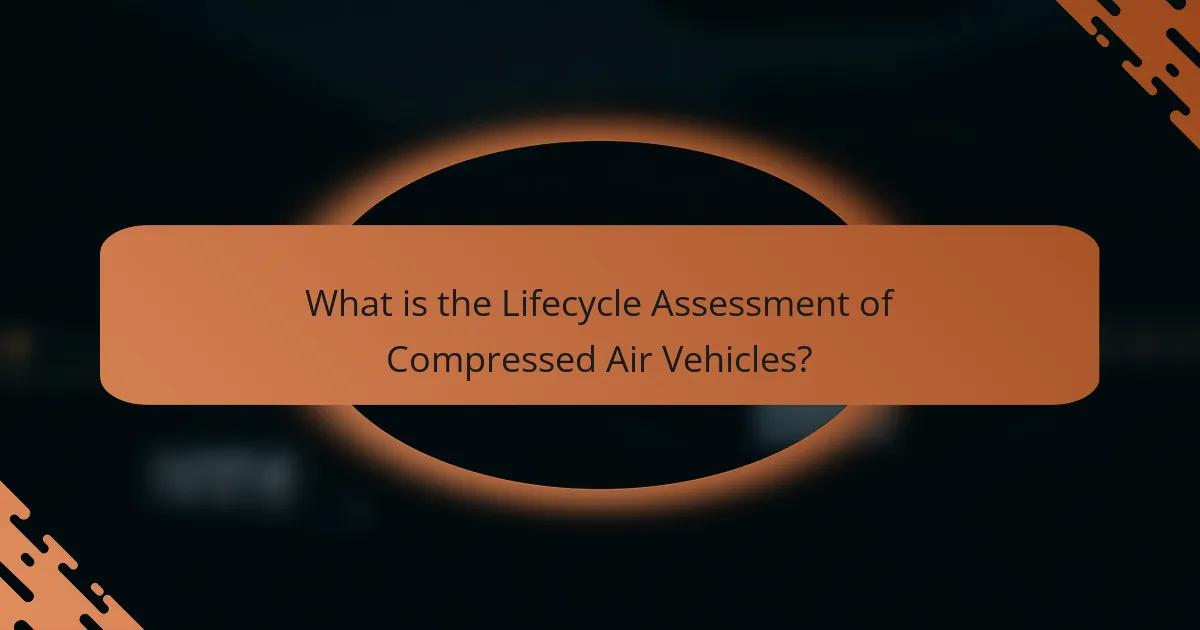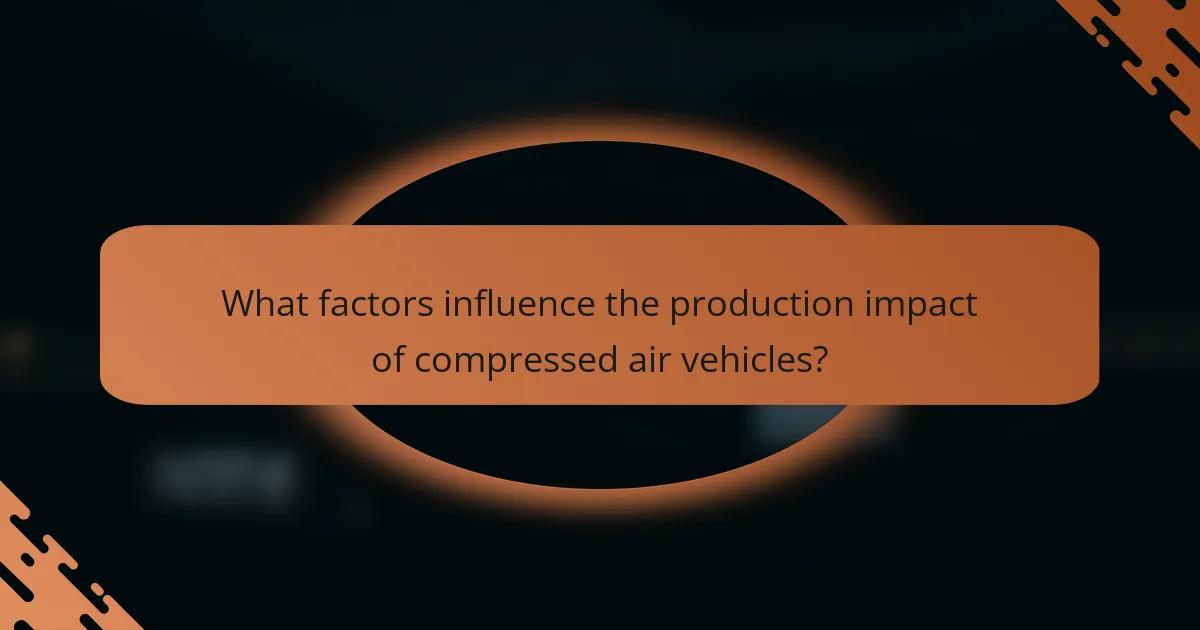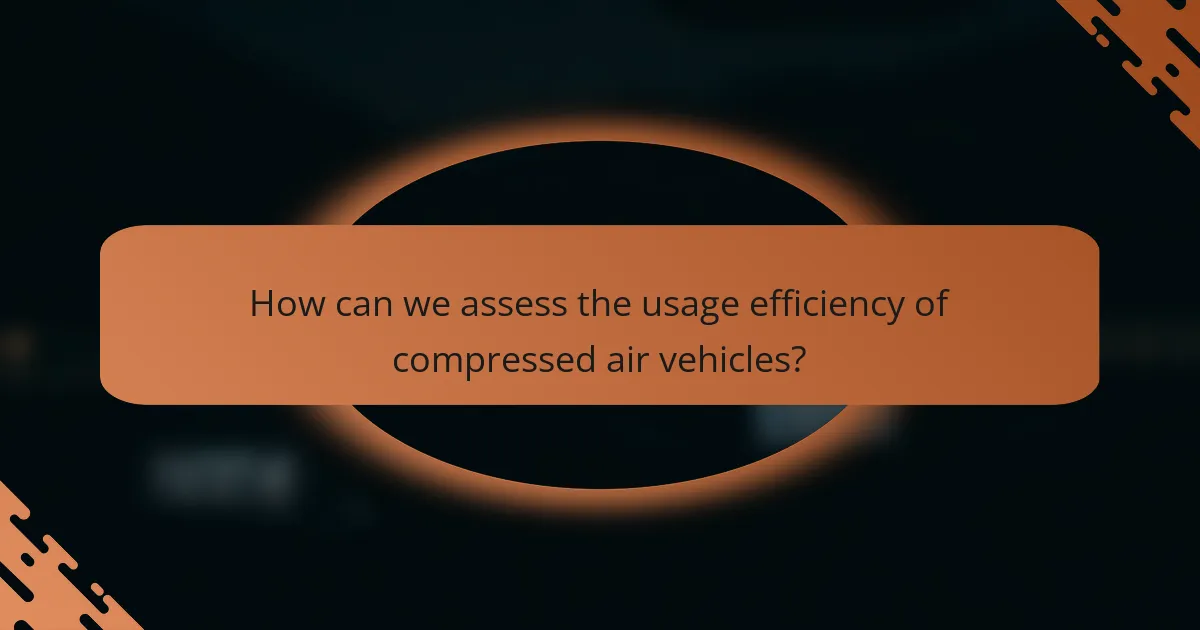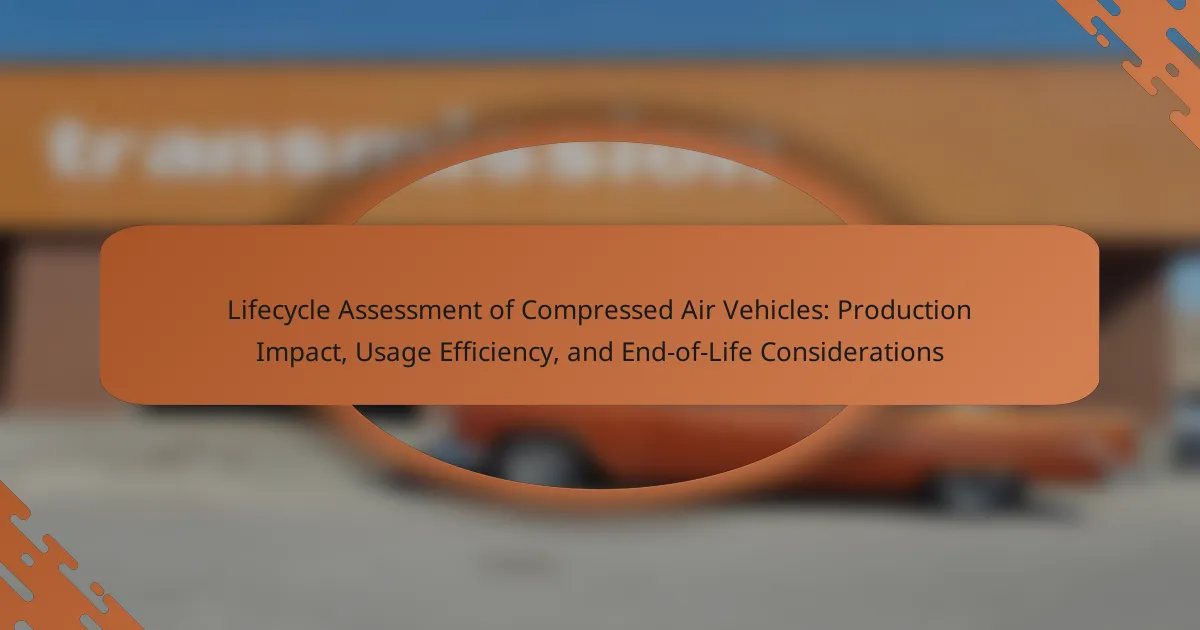The article focuses on the lifecycle assessment of compressed air vehicles, evaluating their environmental impact from production to disposal. It examines critical factors such as resource extraction, manufacturing processes, energy consumption, and emissions throughout the vehicle’s life. The assessment highlights the influence of materials and manufacturing techniques on sustainability and efficiency, while also analyzing key performance indicators related to energy consumption and operational costs. By providing a comprehensive overview of the production impact, usage efficiency, and end-of-life considerations, the article informs stakeholders about the ecological footprint and potential improvements in compressed air vehicle technology.

What is the Lifecycle Assessment of Compressed Air Vehicles?
The Lifecycle Assessment of Compressed Air Vehicles evaluates their environmental impact from production to disposal. It examines resource extraction, manufacturing processes, and energy consumption during vehicle operation. Additionally, it assesses emissions and waste generated throughout the vehicle’s life. Studies indicate that compressed air vehicles can have lower greenhouse gas emissions compared to traditional vehicles. However, the efficiency of air compression and storage methods significantly influences overall sustainability. Lifecycle assessments help identify areas for improvement in design and manufacturing practices. This comprehensive analysis informs stakeholders about the ecological footprint of compressed air technology.
How is the lifecycle of compressed air vehicles defined?
The lifecycle of compressed air vehicles is defined by three main phases: production, usage, and end-of-life. During the production phase, materials are sourced and assembled into the vehicle. This phase includes the extraction of raw materials, manufacturing processes, and transportation to the assembly location. The usage phase involves the operation of the vehicle, where compressed air is utilized as the energy source. This phase measures efficiency in energy consumption and performance metrics. Finally, the end-of-life phase encompasses the disposal or recycling of vehicle components. This phase assesses environmental impact and resource recovery potential. Each phase contributes to the overall lifecycle assessment, impacting sustainability and efficiency.
What stages are included in the lifecycle assessment?
The stages included in the lifecycle assessment are raw material extraction, production, distribution, use, and end-of-life. Each of these stages evaluates the environmental impacts associated with a product. Raw material extraction assesses the sustainability of resources used. Production examines the manufacturing processes and energy consumption. Distribution focuses on the transportation and logistics involved. Use analyzes the operational efficiency during the product’s life. End-of-life considers disposal, recycling, and environmental effects post-consumption. These stages collectively provide a comprehensive view of the product’s overall environmental impact.
Why is lifecycle assessment important for compressed air vehicles?
Lifecycle assessment is important for compressed air vehicles because it evaluates their environmental impacts throughout their entire lifespan. This assessment considers production, usage, and end-of-life phases. It helps identify areas for improvement in energy efficiency and resource use. By analyzing emissions and energy consumption, stakeholders can make informed decisions. Research indicates that lifecycle assessments can reveal significant reductions in greenhouse gas emissions. This information supports the development of more sustainable technologies. Ultimately, lifecycle assessment aids in minimizing the ecological footprint of compressed air vehicles.
What are the key components of compressed air vehicle production?
The key components of compressed air vehicle production include the air storage system, propulsion mechanism, and vehicle structure. The air storage system typically consists of high-pressure tanks designed to hold compressed air efficiently. The propulsion mechanism utilizes compressed air to drive a piston or turbine, converting air energy into mechanical energy. The vehicle structure encompasses the frame, body, and integration of all components to ensure safety and functionality. Additionally, the production process involves materials selection, manufacturing techniques, and assembly practices. Each of these components plays a critical role in the overall performance and efficiency of compressed air vehicles.
How do materials used in production impact the environment?
Materials used in production significantly impact the environment through resource depletion, pollution, and waste generation. The extraction of raw materials often leads to habitat destruction and biodiversity loss. Manufacturing processes can release harmful emissions and pollutants into the air and water. For example, the production of metals requires significant energy and generates greenhouse gases. Additionally, non-renewable resources contribute to long-term environmental degradation. The use of sustainable materials can mitigate these effects by reducing energy consumption and emissions. According to a study by the Environmental Protection Agency, adopting eco-friendly materials can lower the carbon footprint of production by up to 30%. Thus, the choice of materials plays a crucial role in determining the environmental impact of production processes.
What manufacturing processes are involved in producing compressed air vehicles?
Compressed air vehicles are produced through several key manufacturing processes. These processes include design and engineering, material selection, component fabrication, assembly, and quality control.
Design and engineering involve creating detailed specifications for the vehicle’s structure and systems. Material selection focuses on choosing lightweight and durable materials that can withstand high pressures. Component fabrication includes the production of parts such as tanks, valves, and motors, often using techniques like casting, machining, and molding.
Assembly is the process of integrating all components into a complete vehicle. Quality control ensures that each vehicle meets safety and performance standards before it is released to the market. These processes collectively contribute to the efficient production of compressed air vehicles.
What are the environmental impacts during the usage phase of compressed air vehicles?
Compressed air vehicles primarily generate zero tailpipe emissions during their usage phase. This characteristic significantly reduces air pollution compared to conventional vehicles. However, the environmental impact is influenced by the source of the compressed air. If the air is compressed using fossil fuels, indirect emissions occur. Energy consumption during compression can also contribute to greenhouse gas emissions. Additionally, noise pollution is a concern, as compressed air vehicles can produce sound during operation. Overall, the usage phase of compressed air vehicles presents both benefits and challenges for environmental sustainability.
How does energy efficiency compare to traditional vehicles?
Energy efficiency in compressed air vehicles is significantly higher than in traditional vehicles. Compressed air vehicles convert stored air energy into motion more effectively. Traditional vehicles primarily rely on internal combustion engines, which have lower thermal efficiency. Studies show that internal combustion engines operate at around 20-30% efficiency. In contrast, compressed air systems can achieve efficiencies exceeding 50%. This means compressed air vehicles can travel further on the same energy input. Additionally, compressed air vehicles produce zero tailpipe emissions, contributing to cleaner air. This efficiency advantage can lead to reduced operational costs over time.
What emissions are associated with the operation of compressed air vehicles?
Compressed air vehicles primarily emit no direct greenhouse gases during operation. They utilize compressed air as a propulsion mechanism, which does not involve combustion. However, emissions may occur indirectly from the energy sources used to compress the air. If fossil fuels power the compressors, carbon dioxide and other pollutants may be released. Studies indicate that the overall lifecycle emissions depend on the energy mix used for air compression. Renewable energy sources can significantly reduce these emissions.
How do we evaluate the end-of-life considerations for compressed air vehicles?
Evaluating end-of-life considerations for compressed air vehicles involves assessing their recyclability and environmental impact. This includes analyzing the materials used in their construction. Common materials include metals and composites, which may have varying recycling processes.
Next, we consider the disposal methods available for these vehicles. Proper disposal can minimize environmental harm. Life Cycle Assessments (LCA) can quantify the overall environmental impact. These assessments provide data on emissions and resource usage throughout the vehicle’s life.
Additionally, regulations and standards play a crucial role in end-of-life evaluations. Compliance with these regulations ensures safe disposal and recycling practices. Stakeholder engagement is also important, as it can influence end-of-life strategies.
Research indicates that effective end-of-life management can significantly reduce overall carbon footprints. For instance, recycling metals from compressed air vehicles can save energy compared to mining new materials. Thus, a comprehensive evaluation includes material analysis, disposal methods, compliance, and stakeholder involvement.
What recycling processes are available for compressed air vehicle components?
Recycling processes for compressed air vehicle components include material recovery, remanufacturing, and energy recovery. Material recovery involves separating metals, plastics, and composites for reuse. Remanufacturing restores components to original specifications, extending their lifecycle. Energy recovery converts non-recyclable materials into energy through processes like incineration. These methods reduce waste and promote sustainability in the lifecycle of compressed air vehicles.
How does the disposal of compressed air vehicles affect the environment?
The disposal of compressed air vehicles can negatively impact the environment. These vehicles often contain materials that are difficult to recycle. For instance, composite materials used in their structure may end up in landfills. Landfills can release harmful substances into the soil and groundwater. Additionally, improper disposal may lead to the release of compressed air pollutants. These pollutants can contribute to air quality issues. Recycling processes for components like batteries are not always efficient. This can result in waste that could otherwise be reused or repurposed. Overall, the end-of-life management of compressed air vehicles poses environmental challenges that need to be addressed.

What factors influence the production impact of compressed air vehicles?
The production impact of compressed air vehicles is influenced by factors such as materials used, manufacturing processes, and energy consumption. The choice of materials affects the vehicle’s weight and durability. Lightweight materials can enhance efficiency but may increase production costs. Manufacturing processes, including assembly techniques, also play a crucial role in determining environmental impact. Energy consumption during production contributes to the overall carbon footprint. The sourcing of materials can further affect sustainability, particularly if they are derived from non-renewable resources. Additionally, the scale of production influences the efficiency of resource utilization. Higher production volumes can lead to economies of scale, reducing the per-unit impact. These factors collectively shape the lifecycle assessment of compressed air vehicles.
How do resource extraction and processing affect production impact?
Resource extraction and processing significantly influence production impact by determining the environmental footprint and resource efficiency of manufacturing processes. The extraction of raw materials often leads to habitat destruction and pollution. For instance, mining activities can result in soil erosion and water contamination. Processing these resources typically consumes substantial energy, contributing to greenhouse gas emissions. According to the International Energy Agency, the industrial sector accounts for about 24% of global CO2 emissions, largely due to energy-intensive resource processing. Efficient resource management can mitigate these impacts, enhancing sustainability in production. Therefore, the methods used in resource extraction and processing directly correlate with the overall environmental impact of production.
What are the sustainability considerations in resource sourcing?
Sustainability considerations in resource sourcing involve assessing environmental impact, resource availability, and social implications. Evaluating the carbon footprint of materials used is crucial. This includes analyzing extraction methods and their effects on ecosystems. Ethical sourcing practices must be prioritized to ensure fair labor conditions. Resource depletion rates should inform sourcing decisions to promote long-term viability. Additionally, considering the recyclability of materials contributes to reducing waste. Life cycle assessments can provide data on environmental impacts throughout the production process. These considerations ultimately guide companies toward more sustainable practices in sourcing resources.
How do transportation logistics contribute to production emissions?
Transportation logistics contribute to production emissions by facilitating the movement of goods, which often relies on fossil fuel-powered vehicles. These vehicles emit greenhouse gases during transportation, increasing the overall carbon footprint of production. The logistics process includes various stages such as warehousing, inventory management, and distribution. Each of these stages requires energy, often derived from non-renewable sources. According to the Environmental Protection Agency, transportation accounts for about 29% of total greenhouse gas emissions in the United States. Therefore, inefficient transportation logistics amplify emissions associated with product manufacturing. Additionally, longer transport distances typically result in higher emissions. This relationship underscores the importance of optimizing logistics to reduce production-related emissions.
What role does technology play in enhancing production efficiency?
Technology significantly enhances production efficiency by automating processes and optimizing resource use. Automation reduces manual labor and minimizes human error. This leads to faster production cycles and consistent output quality. Advanced software solutions enable real-time monitoring and data analysis. Such capabilities allow for quick adjustments in production lines, improving responsiveness to demand changes. Additionally, technologies like IoT facilitate better inventory management, reducing waste and costs. Research indicates that companies adopting automation see productivity increases of 20-30%. Therefore, technology is essential for improving production efficiency in various industries.
How can innovative manufacturing techniques reduce environmental impact?
Innovative manufacturing techniques can reduce environmental impact by minimizing waste and energy consumption. Techniques such as additive manufacturing, or 3D printing, create products layer by layer. This process reduces material waste compared to traditional subtractive methods. Advanced automation and robotics enhance precision in production, leading to less energy use.
Additionally, the use of sustainable materials, like bioplastics, contributes to lower carbon footprints. Innovations in recycling processes allow for repurposing materials effectively. For example, closed-loop manufacturing systems recycle waste back into production. Studies show that these methods can lower emissions by up to 30%.
Overall, innovative manufacturing techniques promote efficiency and sustainability, significantly reducing environmental impact.
What advancements in materials science benefit compressed air vehicle production?
Advancements in materials science that benefit compressed air vehicle production include the development of lightweight composites and advanced alloys. These materials reduce overall vehicle weight, improving energy efficiency. Innovations in nanomaterials enhance strength and durability while maintaining low weight. Enhanced thermal insulation materials improve energy retention in compressed air systems. Research indicates that carbon fiber composites can reduce weight by up to 50% compared to traditional materials. Additionally, advancements in 3D printing allow for complex geometries, reducing material waste and production costs. These advancements collectively contribute to more efficient and sustainable compressed air vehicle production.

How can we assess the usage efficiency of compressed air vehicles?
To assess the usage efficiency of compressed air vehicles, we can analyze several key performance indicators. These indicators include energy consumption per distance traveled and the overall range achieved on a full charge. Measuring the energy input required to compress air and the energy output during vehicle operation is essential.
Additionally, evaluating the vehicle’s acceleration and deceleration performance provides insight into its efficiency. Comparing these metrics against traditional fuel-based vehicles can further contextualize efficiency levels.
Data from studies show that compressed air vehicles can have lower operational costs compared to conventional vehicles, particularly in urban settings. The efficiency assessment can also include maintenance requirements and the lifespan of the vehicle’s components.
By integrating these factors, we can create a comprehensive evaluation of compressed air vehicle efficiency.
What metrics are used to measure efficiency during operation?
Key metrics used to measure efficiency during operation include energy consumption, operational output, and system reliability. Energy consumption quantifies the amount of energy used per unit of output. Operational output measures the effective work produced relative to energy input. System reliability assesses the frequency of operational failures during use. These metrics provide a comprehensive view of operational efficiency. For instance, a study by the U.S. Department of Energy highlights that reducing energy consumption can lead to significant cost savings and improved performance in compressed air systems.
How does the design of compressed air vehicles affect their performance?
The design of compressed air vehicles significantly impacts their performance. Aerodynamic shapes enhance efficiency by reducing drag. Lightweight materials improve acceleration and energy consumption. The arrangement of air storage tanks affects weight distribution and stability. Effective insulation minimizes energy loss during operation. Engine design influences power output and responsiveness. Overall, these design elements collectively determine speed, range, and operational efficiency. For instance, streamlined designs can increase range by up to 30% compared to less aerodynamic alternatives.
What are the real-world performance statistics for compressed air vehicles?
Compressed air vehicles typically achieve a range of performance statistics that vary based on design and application. For instance, the maximum range of compressed air vehicles is generally around 100 to 200 kilometers on a single charge. The top speed for these vehicles often reaches up to 70 kilometers per hour.
Efficiency ratings can vary, but some models demonstrate an energy consumption of approximately 0.5 to 1.0 kWh per kilometer. The acceleration from 0 to 50 kilometers per hour usually takes about 10 to 15 seconds.
Compressed air vehicles may experience a refueling time of around 3 to 5 minutes when using high-pressure air filling stations. Their operational costs can be lower than traditional vehicles, with estimates suggesting savings of 30% to 50% in fuel costs.
Real-world tests have shown that compressed air vehicles can produce emissions close to zero during operation, contributing positively to environmental goals.
What are the best practices for optimizing the usage of compressed air vehicles?
Regular maintenance is essential for optimizing the usage of compressed air vehicles. This includes checking the air pressure regularly to ensure optimal performance. Properly maintaining the air compressor can enhance efficiency and prolong the vehicle’s lifespan.
Training operators on best practices is also crucial. Knowledgeable operators can maximize the efficiency of compressed air systems. They should understand the importance of minimizing leaks, as leaks can significantly reduce efficiency.
Implementing energy-efficient components can further optimize usage. Upgrading to high-efficiency compressors can lead to substantial energy savings.
Monitoring the vehicle’s performance through data analytics helps identify areas for improvement. Analyzing usage patterns can inform adjustments that enhance efficiency.
Finally, scheduling regular audits on the compressed air system can uncover inefficiencies. Regular assessments ensure that the system operates at peak performance.
How can users maximize the efficiency of compressed air vehicles?
Users can maximize the efficiency of compressed air vehicles by ensuring optimal air pressure levels. Maintaining proper tire pressure enhances vehicle performance. Regular maintenance checks prevent air leaks and ensure efficient operation. Utilizing lightweight materials in vehicle design reduces energy consumption. Implementing aerodynamic designs minimizes drag, improving overall efficiency. Training drivers in eco-friendly driving techniques can further enhance performance. Monitoring energy usage helps identify areas for improvement. Studies show that these practices can significantly increase the range and efficiency of compressed air vehicles.
What maintenance practices should be followed for optimal performance?
Regular maintenance practices for compressed air vehicles include checking air filters, inspecting hoses, and monitoring pressure levels. Clean air filters improve airflow and efficiency. Inspecting hoses prevents leaks and ensures proper function. Monitoring pressure levels optimizes energy use and performance. Routine lubrication of moving parts reduces wear and tear. Additionally, conducting regular system diagnostics identifies potential issues early. Following manufacturer guidelines for maintenance schedules enhances reliability. These practices contribute to the overall longevity and efficiency of compressed air vehicles.
What are the common challenges faced in the lifecycle assessment of compressed air vehicles?
Common challenges in the lifecycle assessment of compressed air vehicles include data availability and quality. Accurate data on material sourcing, production processes, and energy consumption is often limited. Variability in energy sources used during production complicates assessments. Additionally, the efficiency of compressed air systems can vary widely based on design and usage. End-of-life management poses another challenge, as recycling options for components may be unclear. These challenges hinder comprehensive evaluations of environmental impacts. Studies indicate that incomplete data can lead to significant inaccuracies in lifecycle assessments.
How can these challenges be addressed in future assessments?
Future assessments can address challenges by incorporating more comprehensive data collection methods. Enhanced modeling techniques can improve accuracy in predicting lifecycle impacts. Utilizing standardized metrics will facilitate better comparisons across different assessments. Engaging stakeholders early in the process can ensure diverse perspectives are considered. Implementing iterative assessment processes can allow for ongoing refinement and adaptation. Integrating advancements in technology can enhance data analysis capabilities. Collaborating with industry experts can provide insights into best practices. Lastly, establishing regulatory frameworks can promote consistency and reliability in assessments.
What role do regulations play in shaping lifecycle assessments?
Regulations play a critical role in shaping lifecycle assessments by establishing standards and guidelines for environmental impact evaluation. They ensure that assessments consider various stages, including production, usage, and end-of-life. Regulations often require specific methodologies to be used, promoting consistency and comparability across assessments. For instance, the ISO 14040 series outlines principles and framework for conducting lifecycle assessments. Compliance with regulations can drive innovation, leading to more sustainable practices in design and manufacturing. Additionally, regulations can influence market dynamics by incentivizing companies to adopt environmentally friendly technologies. Overall, regulations are essential for ensuring that lifecycle assessments accurately reflect the environmental impacts of products, including compressed air vehicles.
The main entity of this article is the Lifecycle Assessment of Compressed Air Vehicles, which evaluates their environmental impact throughout production, usage, and end-of-life phases. The article discusses the stages involved in the lifecycle assessment, key components of production, and the environmental impacts during vehicle operation. It highlights the importance of assessing sustainability, energy efficiency, and emissions, while also addressing challenges in lifecycle evaluation and the role of regulations. Comprehensive insights into materials, manufacturing processes, and end-of-life considerations are provided to inform stakeholders about the ecological footprint of compressed air technology.
